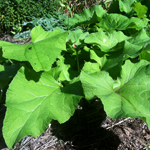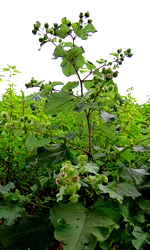Burdock
Articum lappa
family:Asteraceae

the plant: Burdock is a biennial with big leaves shaped like rhubarb leaves, on long petioles arranged in a basal rosette. The leaves are white and wooly beneath and the margins are scalloped. Burdock has purple-pink flowers that look a bit like thistles, presenting on long stalks in clusters. After bloom they become burred seedpods with hooked spines. The root is a single thick taproot that can grow to over a foot long.
Not native to California, burdock has been naturalized and grows wild in disturbed areas here and througout North America.
parts used: root & rhizome (most common); seed, leaf
medicinal actions: alterative, diuretic, antipyretic, bitter, tonic
preparation: tea, tincture, eaten as food
contraindications: None
indications: Burdock is a sweet, cooling & nutritive medicine. David Hoffmann says it best: "In general, burdock will move the body to a state of integration and health, improving indicators of system imbalance, such as skin problems... ." Matthew Wood refers to Native American tradition in considering Burdock to be "bear medicine" - a rich, fatty root that nourishes and strengthens the body. The seeds are a source of essential fatty acids.
Burdock's medicine is today most often associated with supporting the liver and skin. Burdock is a bitter digestive stimulant and supporter of kidney function. Burdock can soothe inflammatory skin conditions like psoriasis, eczema, dandruff & acne.
 Burdock can also help with digestion and appetite through stimulating digestive secretions, and can be a possible support in anorexia nervosa. It can support treatment of arthritis, cystitis and chronic, stagnant conditions that call for moistening, nourishing & clearing. At the right dosages it is said to help purify the liver, lymph & blood.
Burdock can also help with digestion and appetite through stimulating digestive secretions, and can be a possible support in anorexia nervosa. It can support treatment of arthritis, cystitis and chronic, stagnant conditions that call for moistening, nourishing & clearing. At the right dosages it is said to help purify the liver, lymph & blood.
The liver in Eastern medicine traditions is associated with the fire element, and burdock is thought to be an excellent cooling remedy for excess or built up fire in the liver. It can be applied externally as a poultice to assist healing of wounds or ulcers. It combines well with elimination-stimulating herbs like yellow dock, red clover, cleavers or dandelion.
note: This information is not a replacement for a trained herbalist. Please consult your medical professional before treating yourself or others with this or any other herbal remedy.